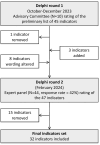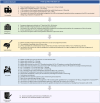Development of a Quality Indicator Set for the Optimal Acute Management of Moderate to Severe Traumatic Brain Injury in the Australian Context
- PMID: 39237845
- PMCID: PMC11950108
- DOI: 10.1007/s12028-024-02107-x
Development of a Quality Indicator Set for the Optimal Acute Management of Moderate to Severe Traumatic Brain Injury in the Australian Context
Abstract
Background: The aim of this study was to develop a consensus-based set of indicators of high-quality acute moderate to severe traumatic brain injury (msTBI) clinical management that can be used to measure structure, process, and outcome factors that are likely to influence patient outcomes. This is the first stage of the PRECISION-TBI program, which is a prospective cohort study that aims to identify and promote optimal clinical management of msTBI in Australia.
Methods: A preliminary set of 45 quality indicators was developed based on available evidence. An advisory committee of established experts in the field refined the initial indicator set in terms of content coverage, proportional representation, contamination, and supporting evidence. The refined indicator set was then distributed to a wider Delphi panel for assessment of each indicator in terms of validity, measurement feasibility, variability, and action feasibility. Inclusion in the final indicator set was contingent on prespecified inclusion scoring.
Results: The indicator set was structured according to the care pathway of msTBI and included prehospital, emergency department, neurosurgical, intensive care, and rehabilitation indicators. Measurement domains included structure indicators, logistic indicators, and clinical management indicators. The Delphi panel consisted of 44 participants (84% physician, 12% nursing, and 4% primary research) with a median of 15 years of practice. Of the 47 indicators included in the second round of the Delphi, 32 indicators were approved by the Delphi group.
Conclusions: This study identified a set of 32 quality indicators that can be used to structure data collection to drive quality improvement in the clinical management of msTBI. They will also be used to guide feedback to PRECISION-TBI's participating sites.
Keywords: Benchmarking; Critical care; Quality indicators; Quality of care; Traumatic brain injuries.
© 2024. The Author(s).
Conflict of interest statement
Conflict of interest: The authors declare that they have no conflicts of interest. Ethical Approval/Informed Consent: Not applicable.
Figures



References
-
- O’Reilly GM, Curtis K, Mitra B, et al. Hospitalisations and in-hospital deaths following moderate to severe traumatic brain injury in Australia, 2015–20: a registry data analysis for the Australian Traumatic Brain Injury National Data (ATBIND) project. Med J Aust. 2023;219(7):316–24. 10.5694/mja2.52055. - PubMed
MeSH terms
Grants and funding
LinkOut - more resources
Full Text Sources
Medical

